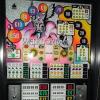Leaderboard
-
[[Template core/front/popular/memberRow is throwing an error. This theme may be out of date. Run the support tool in the AdminCP to restore the default theme.]]
[[Template core/front/popular/memberRow is throwing an error. This theme may be out of date. Run the support tool in the AdminCP to restore the default theme.]]
[[Template core/front/popular/memberRow is throwing an error. This theme may be out of date. Run the support tool in the AdminCP to restore the default theme.]]
[[Template core/front/popular/memberRow is throwing an error. This theme may be out of date. Run the support tool in the AdminCP to restore the default theme.]]
Popular Content
Showing content with the highest reputation on 06/17/21 in all areas
-
I have a chicago coin Olympics in the garage. 1976. Tips: Clean every metal contact in the base and the head. They'll be heavier duty contacts, a light clean with a business card between the pads is normally ok. Some people use contact cleaner..which is a great way of swilling dirt to places you can't reach. You can use a worn file for the heavier duty contacts, but the goal is to remove the carbon build up, not to file down the contacts..it will make matters worse. Things that move: Score reels. You'll need to remove these, and inspect that everything moves freely, and makes contact. You probably will have to replace coil sleeves, as they get packed with dirt, and allow plungers to stick. Check that the score reel wafer (the bit that presses up against reel, as it turns) is making good contact. This may take several hours of checking each position with a Multi-meter Playfield contacts: Clean and clean..and clean more. Check for contact, loose wires, missing coils Flippers, old EM's have worn flipper bushings, links plungers. Rebuild the lot. The only thing that you should not have to replace is the coil. End of Stroke (EOS) switches. These are normally attached to the flipper mechs. They are normally closed, and forced to open when the flipper is fully turned. make sure the switch stays closed until the very last moment. at that point the EOS must be open so that coil is de-energised In General..EM's have the plus that everything is normally there, but need a LOT of work to get going, and when they do, you need to play it regularly to keep it going. Lots of good tips on Pinside forums. Look for Joe's Classic arcade on You Tube. He is a good source of how to, and knowledge. Statto5 points
-
Unless there is a sign of burning(usually blackens the cover) then those relays should be fine and no need to open them up. the buzzing could be the coin mech lockout coils, they control the bar that comes across to stop extra coins from being inserted from the front The coil and the lockout bar plate are just be dirty or the coil loose will cause a buzzing sound.2 points
-
What makes me say this, is the 4MHz clock crystal. If it goes to pins 15 and 16 on U2, then it's almost certainly a PIC microcontroller, possibly a 16F627 or 16F628 given the age of the machine. It would be interesting to see what is under the label that says "C033 V00"2 points
-
More observations, now I've had chance to jump on a PC and look at the photos properly.... The wiring around the power socket looks fine to me. Power comes in via the IEC socket, the live wire goes via one of the fuseholders (the other is unused) to the power switch, then on to the rest of the machine. If the machine lights up and the display board briefly flashes on power up, the mains wiring must be fine so leave it alone! Certainly don't mess around with the fuse, it's there for safety reasons and should be of the correct type (time delay or quick blow) and the correct ampage. The ratings label on the back of the machine should give details of the required fuse values. The display board appears to be built around a microcontroller of some sort, probably a PIC, at position U2. This will be responsible for the display flashing briefly on power-up. Until is gets some data to display from the main board (whatever is at the other end of the flat cable) it will just sit there doing nothing. The design of the display board looks almost textbook to me. AC power comes in with the data on the 8-pin connector. The AC is rectified to DC via diodes D12 to D15, smoothed by C6 and then regulated down to 5 volts by U5 and C7/C8. A secondary module in the corner produces the voltages required by the display glass. The OKI chip is the display driver, and the two DS2003CN chips drive the LEDs. U6 appears to be a 74HC14N buffer chip that buffers the incoming data signal from the main board before passing it on to the microcontroller. I'll stand by what I said earlier. The mains wiring looks okay so I'd leave it alone. The display board appears to be okay and is just waiting for some data to be sent to it from whatever the other end of the flat cable is plugged into. Please add some photos of what the cable is connected to at the other end and we'll go from there.2 points
-
Thought I'd share this with you all. A friend of mine has created a Snappy Viper game on his zx spectrum. Its quite amusing and clever how he did this Hope you can get to watch this and leave a comment for him. Cheers.1 point
-
I have recently rescued a Peter simper fruit machine from a cellar in Accrington, doesn't appear to have been used for quite a while, the reels were not turning, but after a bit of tlc they are now working, main problem is it is not paying out coins, when you get a winning line there is nothing, no noise or clicks or anything. the hopper is now moving and have just got it back from a tv repair shop who say that the resistors and capacitors are ok, so now checking the relay solenoids ( two of them attatched to the hopper mech, trouble is they are incased in a plastic cover and not sure the best way to remove them without braking them, also another issue is there is a lock on the side of the machine which when turned connects to the 2p mech and opens that up as does the switch on the top of the back of the cabinet which presses in when you close the cabinet, they are both making a buzzing noise when on, is this normal ? Any help and advice most welcome, I am still a bit green when it comes to the electrics.1 point
-
Also check that none of the four resistor packs (long black things) around the OKI chip are damaged. They're delicate and I've seen them be cracked right down the middle many times before.1 point
-
That's a good sign and narrows down the fault to the display board, specifically the display tube, the OKI chip or the power supply sub board. If you look at the display tube in a darkened room you should be able to see about three or four heater wires glowing red across the length of the display. If they're not lit up then the power supply sub board is probably faulty or the two capacitors next to it. It might be a bit of a bugger to fix because the display tube is in the way of some of the solder joints on the other side of the board. It does look like you can get to the pins of the sub board and the two caps though.1 point
-
Ive just discovered that the bulbs on the alpha do light up. I suspect in turn as the pot increases until its ready to drop Happy days1 point
-
It looks like someone has replaced a diode on display board,double check for dry and dodgy joints, looks a nice machine and if it works I doubt the issue will be much.nice research by canon man and very impressive responses.nice one dude.is it not possible to put 5 volt into display on the bench,its kind of self driven for the most part so should display something.1 point
-
Yup, you're right, it is the same one. Looking at the small flecks underneath the "10p 2 plays" on the glass they are identical to mine. Looking forward to the schematic, gradually identifying some other things that need some fixing, like the double/lose gambler - quite often on a "double" it still loses, and reel one stops at the right time, but then the coil comes on and off a few times so the reel shifts by a few spots each time. I'll start a thread on the forum documenting working my way through it all, might be useful to someone else one day.1 point
-
Thankyou, I will remove the coil and lockout bar plate and clean / tighten them.1 point
-
That's a good point. If the tilt board is connected up and the weight is touching the outer ring then that could stop the machine from working. Maybe unplug the tilt board with the power off then flick the power back on and see what happens? There's also what appears to be a couple of mains power connectors right next to the tilt PCB that are unplugged. I wonder if the should be plugged into each other? I'd still like to know where the flat cable from the display board goes to. I would have expected it to go to the main board (right hand side) but it must go via a junction board somewhere... EDIT: I have a horrible feeling the flat cable is only a few inches long and goes to a board on the back of the coin drop area. Does the machine actually do anything at all, or is it stood silent because it might think it's been tilted? If it were me, I'd still be checking the PSU outputs to see if all voltage rails are present and correct. I'v been looking for a manual but not managed to find anything yet1 point
-
1 point
-
Nice Buy with that AFD Gambler, I actually have a schematic in my library for that machine. I will scan and upload it to the downloads section of the site. AFD stands for the manufacturers name Automatic Fruit Designs LTD Your machine is from circa 1976 but AFD did not survive into the MPU era and went into liquidation in 1979. Much the same as servicing Bally machines, These E/M machines will run well with plenty of TLC.1 point
-
So it was me that picked up this AFD machine and then found this thread courtesy of Mr Google. I agreed with the seller to pay the Buy It Now price if he included delivery. It just arrived and it mostly works. Will coin up, reels spin and made a couple of payouts. Few things a bit sticky, gamble feature sometimes runs sometimes gets stuck and the one reel I held hasn't spun since and it could do with a good clean inside and out. Looking forward to working on it, always wanted a UK EM machine like this. I've done a lot of Bally EM machines over the years now fancy something different. Now the million dollar question...... of course there were no schematics with it, any chance someone might have a source? I realise it somewhere between "no chance" and "no chance at all" but nothing ventured and all that. Any AFD schematic might give me some insight into how the reel mech mechanicals work. Mark1 point
-
Try posting on Pinball Info .com - there are a few stalwarts of the older machines on there who might be able to help. That's where i spend most of my 'forum time'. Friendly bunch, normally. And also UK based. Pinside is also handy, much more traffic, but mostly Americans.1 point
-
Hi Everyone Following on from Snappy Viper My friend Bernard Mitchell has created another game for his ZX Spectrum which is,Super Line Up mpu3. In a similar fashion to Snappy,it has some robotic style sounds which mimmick some of my catchphrases lol. Here is his latest video. And hope you can get to watch it. He would love to hear any feedback if you leave comments for him. I must admit,I like this a lot. His next project is Chances Unlimited. Thanks Massive to Bernard who visited me a few weeks ago and is a genuinely nice chap who is into this stuff. This video and Snappy can be seen on his YouTube channel1 point





